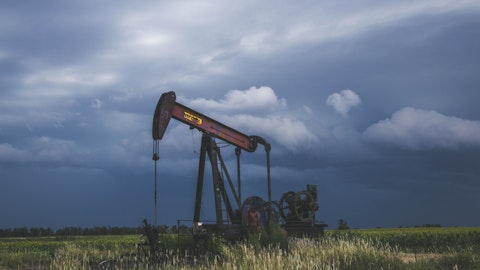Michael Hollis: Absolutely. So Nick, yeah, of course, we’re getting fairly efficient and more efficient every kind of week month as we go with our completion crews. And at HighPeak, we do drill a lot of wells, a lot of lateral foot per rig. So as we sit today, we are able to complete with one of these kind of, again, Tier one frac crews, dual fuel, very efficient. We’re able to complete all of the wells behind kind of to call it 2, 2.5 rigs. So as we mentioned being a slightly front-half weighted on CapEx of B and C, what drives that is we’re able to have completed about a 2.5 rig cadence through the first half of the year and go to a two-rig cadence through the latter half of the year. So that that’s a slightly front end weighted.
So you can imagine toward the back half of the year, you’ll have a couple of a little few day gaps in between the pads. Now as far as the ratability, which means as we’re drilling these wells as soon as we move off of a pad, we move the frac crew in and complete. So the pad sizes we’re drilling in 2024 are very similar to the pad sizes we were drilling in ’23. Hence, ratability per rig will be about the same as well as the completions and turned in line.
Nicholas Pope: Got it. That’s helpful. And switching to the financial side of things. I was hoping you could talk a little bit about the decision to increase the dividend and how you weigh that cash going out the door for the dividend relative to the big term loan that you put in place in the summer. So kind of how you think about what could be paid off? What you’re allowed to to pay down on that new debt instrument? Obviously, it’s got a pretty big note with where interest rates are. So just kind of curious how you’re balancing those cash options kind of outside of drilling right now?
Jack Hightower: Good question, Nick. And our basic answer there is the dividend relative to our annualized basis of $25 million is pretty de minimus. It doesn’t really help us to do another $25 million on a $1 billion to pay down of the loan. But it gives us more value return for the shareholders. Our stock is depressed in our opinion. Hence, the reason we have a share buyback and why you see management in our last offering do a offering. So we’re going to continue that program. And as far as buying back stock, when we negotiated our home. We got permission to do all these things to increase our dividend to do a share buyback and to have that flexibility. And we do have restrictions in terms of pay down of the debt. We have an amortization in place, but we also have restrictions that limit our ability to pay down without any make-whole provision.
Operator: Our next question comes from Jeff Robertson with Waters Tower Research.
Jeff Robertson: Thanks. Good morning. Mike, can you talk a little bit about reserve bookings in the capital program in 2023 and what you anticipate in 2024 and the kind of capital that’s being spent on the program and how that compares to the last several years?
Michael Hollis: You bet, Jeff. Again, as we’ve slowed down activity somewhat, we will be drilling a few less wells, obviously somewhere in the kind of wells drilled in about 60 turn-in lines this year. So again, when you look at the well performance, what we’re drilling today compared to what we did in 2023, the well performance in ’23 was across broad spectrum of both blocks. So the wells that we’re drilling today mirror what we kind of did in 2023 ex the few efficiencies and things that we’re learning as we go along our way. So if you kind of take that forward into what our reserve booking will look like, you can kind of think of 2023 being an average of a four-rig program. So the growth that we saw in 2023, the adds, now that production roll-off was going to be less than the production that we’re going to make in 2024.
It’s going to be close. So I think roughly the same roll off with about half of the adds of reserves. And then, of course, we’re always very conservative on our PUD bookings. So don’t look for us to be a company that’s going to go out and do 60% 70% PUDs and only 30% proved. What we show is our proved reserves is closer to 40%, PUD more like 60% to 65% proved or PUD. So hopefully that gives you a pretty clear picture of what 2024 will look like.



